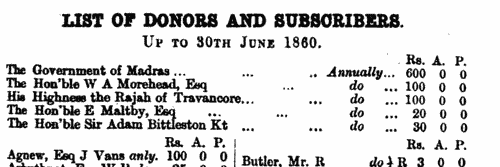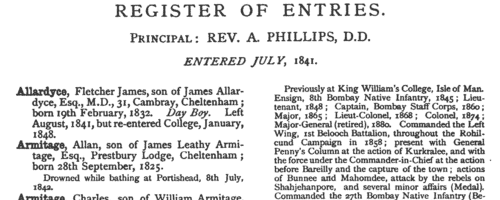 Sailors and marines on board Her Majesty's ship Simoom
(1860) Sailors and marines on board Her Majesty's ship Simoom
(1860)
The China Medal was awarded to soldiers and sailors involved in the various actions of the war against China, in which this ship was engaged in 1860. The medals were either delivered on board or sent on in 1862: except that many of the men were no longer immediately traceable, and the remarks on the roll show that some medals were not sent on for several years, and some were never sent. After the main roll there is a section showing which of the men also qualified for clasps. Separate clasps were awarded for men who had been in receipt of the China Medal of 1842; for the taking of Fatshan in 1857, Canton in 1857, Taku Forts in 1858, Taku Forts in 1860, and Pekin in 1860. Most of the men on this ship are shown as having been given the Taku Forts 1860 clasp, for being actually present at the capture of the Taku Forts 21 August 1860.TAYLOR. Cost: £8.00.  | Sample scan, click to enlarge

|
 Sailors and marines on board Her Majesty's ship Snake
(1860) Sailors and marines on board Her Majesty's ship Snake
(1860)
The China Medal was awarded to soldiers and sailors involved in the various actions of the war against China, in which this ship was engaged in 1860. The medals were either delivered on board or sent on in 1862: except that many of the men were no longer immediately traceable, and the remarks on the roll show that some medals were not sent on for several years, and some were never sent.TAYLOR. Cost: £8.00.  | Sample scan, click to enlarge

|
 Sailors and marines on board Her Majesty's ship Sparrowhawk
(1860) Sailors and marines on board Her Majesty's ship Sparrowhawk
(1860)
The China Medal was awarded to soldiers and sailors involved in the various actions of the war against China, in which this ship was engaged in 1860. The medals were either delivered on board or sent on in 1862: except that many of the men were no longer immediately traceable, and the remarks on the roll show that some medals were not sent on for several years, and some were never sent.TAYLOR. Cost: £8.00.  | Sample scan, click to enlarge

|
 Sailors and marines on board Her Majesty's ship Sphinx
(1860) Sailors and marines on board Her Majesty's ship Sphinx
(1860)
The China Medal was awarded to soldiers and sailors involved in the various actions of the war against China, in which this ship was engaged in 1860. The medals were either delivered on board or sent on in 1862: except that many of the men were no longer immediately traceable, and the remarks on the roll show that some medals were not sent on for several years, and some were never sent. After the main roll there is a section showing which of the men also qualified for clasps. Separate clasps were awarded for men who had been in receipt of the China Medal of 1842; for the taking of Fatshan in 1857, Canton in 1857, Taku Forts in 1858, Taku Forts in 1860, and Pekin in 1860. Most of the men on this ship are shown as having been given the Taku Forts 1860 clasp, for being actually present at the capture of the Taku Forts 21 August 1860.TAYLOR. Cost: £8.00.  | Sample scan, click to enlarge

|
 Sailors and marines on board Her Majesty's ship Volcano
(1860) Sailors and marines on board Her Majesty's ship Volcano
(1860)
The China Medal was awarded to soldiers and sailors involved in the various actions of the war against China, in which this ship was engaged in 1860. The medals were either delivered on board or sent on in 1862: except that many of the men were no longer immediately traceable, and the remarks on the roll show that some medals were not sent on for several years, and some were never sent. After the main roll there is a section showing which of the men also qualified for clasps. Separate clasps were awarded for men who had been in receipt of the China Medal of 1842; for the taking of Fatshan in 1857, Canton in 1857, Taku Forts in 1858, Taku Forts in 1860, and Pekin in 1860. Most of the men on this ship are shown as having been given the Canton clasp, for being actually present at Canton on 28 and 29 December 1857, when that city was bombarded and finally captured.TAYLOR. Cost: £8.00.  | Sample scan, click to enlarge

|
 Sailors and marines on board Her Majesty's ship Vulcan
(1860) Sailors and marines on board Her Majesty's ship Vulcan
(1860)
The China Medal was awarded to soldiers and sailors involved in the various actions of the war against China, in which this ship was engaged in 1860. The medals were either delivered on board or sent on in 1862: except that many of the men were no longer immediately traceable, and the remarks on the roll show that some medals were not sent on for several years, and some were never sent. After the main roll there is a section showing which of the men also qualified for clasps. Separate clasps were awarded for men who had been in receipt of the China Medal of 1842; for the taking of Fatshan in 1857, Canton in 1857, Taku Forts in 1858, Taku Forts in 1860, and Pekin in 1860. Most of the men on this ship are shown as having been given the Taku Forts 1860 clasp, for being actually present at the capture of the Taku Forts 21 August 1860.TAYLOR. Cost: £8.00.  | Sample scan, click to enlarge

|
Supporters of the Madras Civil Orphan Asylum
(1860)
The list of donors and subscribers to the Madras Civil Orphan Asylum, up to 30 June 1860, gives surnames and initials: whether the sum was subscribed annually (anly.) or monthly (mly.) or consisted of donation(s) (don.), in rupees, annas and pies.
TAYLOR. Cost: £4.00.  | Sample scan, click to enlarge

|
Tabular record of Wesleyan mortality
(1860)
The Christian Miscellany and Family Visiter, a Wesleyan Methodist monthly published in London, carried, in most issues, a Tabular Record of Mortality, listing recent deaths. The columns of the table are: Name, Residence, [Methodist] Circuit, Age, and Date of Death.TAYLOR. Cost: £6.00.  | Sample scan, click to enlarge

|
Victoria Intestates
(1860)
The probate courts of the Australian colonies furnished returns of estates of deceased intestates, giving full name, colonial residence, supposed British or foreign residence of family (often unknown, or left blank), amount of the estate and how much had been disbursed and how. The date of death is often stated, and if by accident, suicide or crime. Names were carried forward from return to return until the estate was expended or exhausted. TAYLOR. Cost: £6.00.  | Sample scan, click to enlarge

|
Boys entering Cheltenham College
(1861)
Cheltenham College 'was founded in order to provide for the sons of gentlemen a Classical, Mathematical, and General Education of the highest order, on moderate terms, in strict conformity with the principles and doctrines of the Church of England.'
Andrew Alexander Hunter, the college registrar, compiled the first edition of the College Register in four parts from 1883 to 1886: these merely listed the boys by term of entry, with their dates of birth and names and addresses of their fathers. Circulars were also sent out to all Old Cheltonians whose addresses were known, requesting additional details. On the basis of the returns from these and Hunter's further researches, this much fuller register was published in 1890.
The information after each boy's name is given (where known and applicable) in this format: father's full name and address as of the time the boy entered the college; class and department on entering the college (classes being number from 1 downwards, and these again divided into A and B, some into C and D, others into P (Principal's side) and V. P. (Vice-Principal's side) - 1A was the highest class in each department: besides this, certain others were called Addiscombe, Woolwich, Civil, Direct, Line, Sandhurst, Naval, Special, Preparatory, Latin, and India Civil) and the same on leaving, name of Boarding House (or 'Day Boy'), scholastic and athletic honours attained at the college, and subsequent career (including date and place of death, or present address in 1890, if known).TAYLOR. Cost: £4.00.  | Sample scan, click to enlarge

|
Research your ancestry, family history, genealogy and one-name study by direct access to original records and archives indexed by surname.












